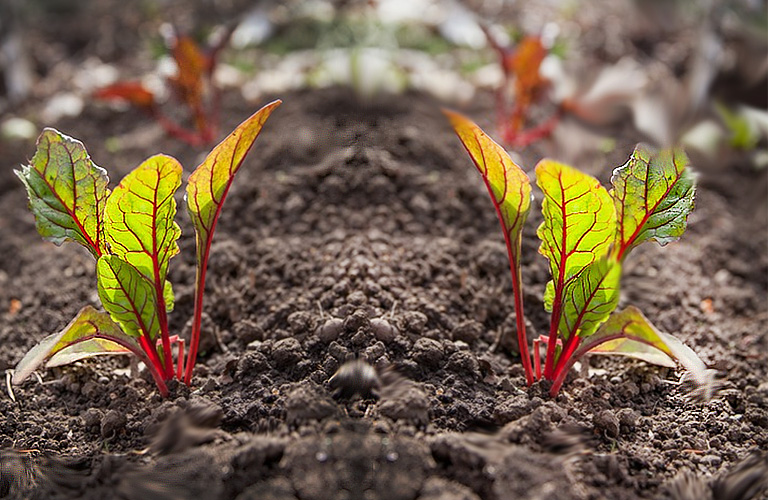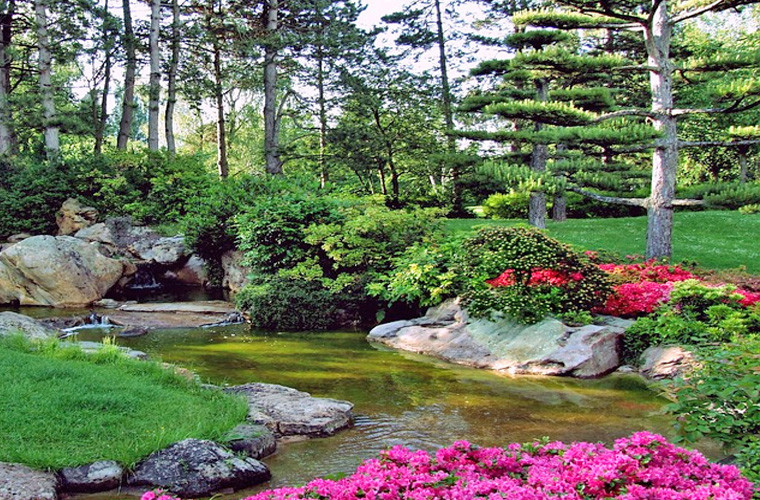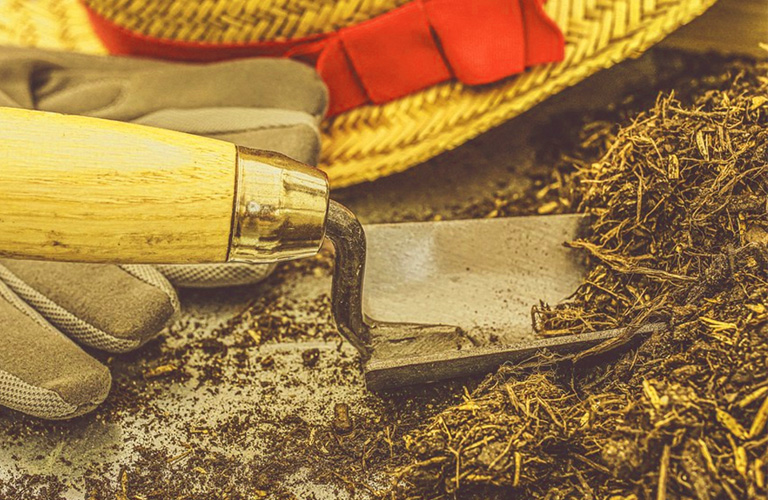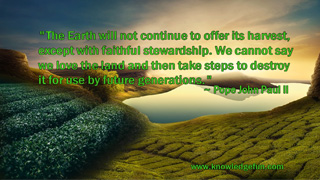Where nature is allowed to operate without human intervention, each place develops a stable level of biomass that is inevitably the highest amount of organic life that site could support. Whether deciduous forest, coniferous forest, prairie, even desert, nature makes the most of the available resources and raises the living drama to its most intense and complex peak possible. There will be as many mammals as there can be, as many insects, as many worms, as many plants growing as large as they can get, as much organic matter in all stages of decomposition and the maximum amount of relatively stable humus in the soil. All these forms of living and decomposing organisms are linked in one complex system; each part so closely connected to all the others that should one be lessened or increased, all the others change as well.
The efficient decomposition of leaves on a forest floor is a fine example of what we might hope to achieve in a compost pile. Under the shade of the trees and mulched thickly by leaves, the forest floor usually stays moist. Although the leaves tend to mat where they contact the soil, the wet, somewhat compacted layer is thin enough to permit air to be in contact with all of the materials and to enter the soil.
Living in this very top layer of fluffy, crumbly, moist soil mixed with leaf material and humus, are the animals that begin the process of humification. Many of these primary decomposers are larger, insect-like animals commonly known to gardeners, including the wood lice that we call pill bugs because they roll up defensively into hard armadillo-like shells, and the highly intrusive earwigs my daughter calls pinch bugs. There are also numerous types of insect larvae busily at work.
A person could spend their entire life trying to understand the ecology of a single handful of humus-rich topsoil. For a century now, numerous soil biologists have been doing just that and still the job is not finished. Since gardeners, much less ordinary people, are rarely interested in observing and naming the tiny animals of the soil, especially are we disinterested in those who do no damage to our crops, soil animals are usually delineated only by Latin scientific names. The variations with which soil animals live, eat, digest, reproduce, attack, and defend themselves fills whole sections of academic science libraries.
During the writing of this book I became quite immersed in this subject and read far more deeply into soil biology and microbiology than I thought I ever would. Even though this area of knowledge has amused me, I doubt it will entertain most of you. If it does, I recommend that you first consult specialist source materials listed in the bibliography for an introduction to a huge universe of literature.
I will not make you yawn by mentioning long, unfamiliar Latin names. I will not astonish you with descriptions of complex reproductive methods and beautiful survival strategies. Gardeners do not really need this information. But managing the earth so that soil animals are helped and not destroyed is essential to good gardening. And there are a few qualities of soil animals that are found in almost all of them. If we are aware of the general characteristics of soil animals we can evaluate our composting and gardening practices by their effect on these minuscule creatures.
Compared to the atmosphere, soil is a place where temperature fluctuations are small and slow. Consequently, soil animals are generally intolerant to sudden temperature changes and may not function well over a very wide range. That's why leaving bare earth exposed to the hot summer sun often retards plant growth and why many thoughtful gardeners either put down a thin mulch in summer or try to rapidly establish a cooling leaf canopy to shade raised beds. Except for a few microorganisms, soil animals breathe oxygen just like other living things and so are dependent on an adequate air supply. Where soil is airless due to compaction, poor drainage, or large proportions of very fine clay, soil animals are few in number.
The soil environment is generally quite moist; even when the soil seems a little dryish the relative humidity of the soil air usually approaches 100 percent. Soil animals consequently have not developed the ability to conserve their body moisture and are speedily killed by dry conditions. When faced with desiccation they retreat deeper into the soil if there is oxygen and pore spaces large enough to move about. So we see another reason why a thin mulch that preserves surface moisture can greatly increase the beneficial population of soil animals. Some single-cell animals and roundworms are capable of surviving stress by encysting themselves, forming a little "seed" that preserves their genetic material and enough food to reactivate it, coming back to life when conditions improve. These cysts may endure long periods of severe freezing and sometimes temperatures of over 150 degree F.
Inhabitants of leaf litter reside close to the surface and so must be able to experience exposure to dryer air and light for short times without damage. The larger litter livers are called primary decomposers. They spend most of their time chewing on the thick reserve of moist leaves contacting the forest floor. Primary decomposers are unable to digest the entire leaf. They extract only the easily assimilable substances from their food: proteins, sugars and other simple carbohydrates and fats. Cellulose and lignin are the two substances that make up the hard, permanent, and woody parts of plants; these materials cannot be digested by most soil animals. Interestingly, just like in a cow's rumen, there are a few larvae whose digestive tract contains cellulose-decomposing bacteria but these larvae have little overall effect.
After the primary consumers are finished the leaves have been mechanically disintegrated and thoroughly moistened, worked over, chewed to tiny pieces and converted into minuscule bits of moist excrement still containing active digestive enzymes. Many of the bacteria and fungi that were present on the leaf surfaces have passed through this initial digestion process alive or as spores waiting and ready to activate.
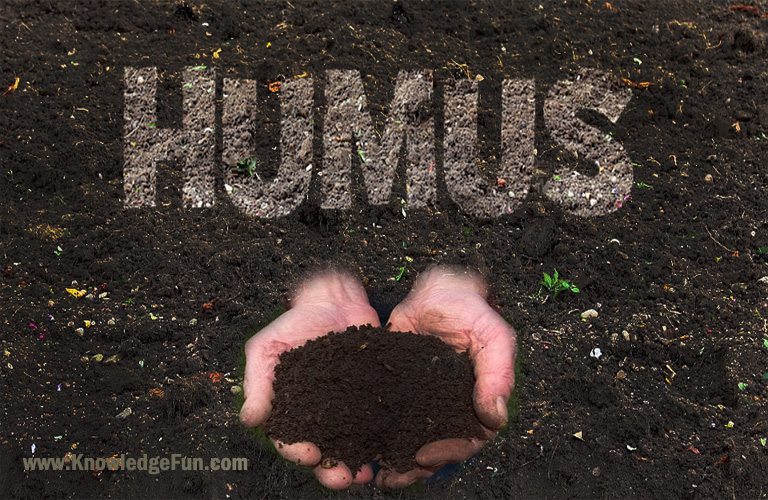
In this sense, the excrement of the primary decomposers is not very different than manure from large vegetarian mammals like cows and sheep although it is in much smaller pieces.
Digestive wastes of primary decomposers are thoroughly inoculated with microorganisms that can consume cellulose and lignin. Even though it looks like humus, it has not yet fully decomposed. It does have a water-retentive, granular structure that facilitates the presence of air and moisture throughout the mass creating perfect conditions for microbial digestion to proceed.
This excrement is also the food for a diverse group of nearly microscopic soil animals called secondary decomposers. These are incapable of eating anything that has not already been predigested by the primary decomposers. The combination of microbes and the digestive enzymes of the primary and secondary decomposers breaks down resistant cellulose and to some degree, even lignins. The result is a considerable amount of secondary decomposition excrement having a much finer crumb structure than what was left by the primary decomposers. It is closer to being humus but is still not quite finished.
Now comes the final stage in humus formation. Numerous species of earthworms eat their way through the soil, taking in a mixture of earth, microbes, and the excrement of soil animals. All of these substances are mixed together, ground-up, and chemically recombined in the worm's highly active and acidic gut. Organic substances chemically unite with soil to form clay/humus complexes that are quite resistant to further decomposition and have an extraordinarily high ability to hold and release the very nutrients and water that feed plants. Earthworm casts (excrement) are mechanically very stable and help create a durable soil structure that remains open and friable, something gardeners and farmers call good tilth or good crumb. Earthworms are so vitally important to soil fertility and additionally useful as agents of compost making that an entire section of this book will consider them in great detail.
Let's underline a composting lesson to be drawn from the forest floor. In nature, humus formation goes on in the presence of air and moisture. The agents of its formation are soil animals ranging in complexity from microorganisms through insects working together in a complex ecology. These same organisms work our compost piles and help us change crude vegetation into humus or something close to humus. So, when we make compost we need to make sure that there is sufficient air and moisture.
Decomposition is actually a process of repeated digestions as organic matter passes and repasses through the intestinal tracts of soil animals numerous times or is attacked by the digestive enzymes secreted by microorganisms. At each stage the vegetation and decomposition products of that vegetation are thoroughly mixed with animal digestive enzymes. Soil biologists have observed that where soil conditions are hostile to soil animals, such as in compacted fine clay soils that exclude air, organic matter is decomposed exclusively by microorganisms. Under those conditions virtually no decomposition-resistant humus/clay complexes form; almost everything is consumed by the bacterial community as fuel. And the non-productive soil is virtually devoid of organic matter.
Sir Albert Howard has been called the 'father of modern composting.' His first composting book (1931) The Waste Products of Agriculture, stressed the vital importance of animal digestive enzymes from fresh cow manure in making compost. When he experimented with making compost without manure the results were less than ideal. Most gardeners cannot obtain fresh manure but fortunately soil animals will supply similar digestive enzymes. Later on when we review Howard's Indore composting method we will see how brilliantly Sir Albert understood natural decomposition and mimicked it in a composting method that resulted in a very superior product.
At this point I suggest another definition for humus. Humus is the excrement of soil animals, primarily earthworms, but including that of some other species that, like earthworms, are capable of combining partially decomposed organic matter and the excrement of other soil animals with clay to create stable soil crumbs resistant to further decomposition or consumption.



